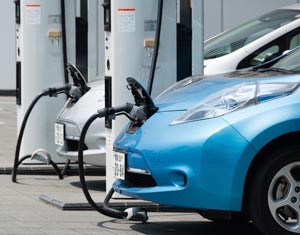I saw X-Men: Days of Future Past over the long weekend, and man, it did not disappoint. The movie began with a depiction of a bleak, dark future destined to be humanity’s fate unless – of course – Professor X, Wolverine, Beast, and the rest of the X-Men (and women) step in to save us. Though X-Men is rooted in fantasy, a bleaker future may be part of our reality if we do nothing to limit the impacts of climate change. And, while there are no mutants to save us (yet), we do have several types of electric vehicles (EVs) that can operate nearly emission-free when powered by clean electricity or hydrogen. UCS analysis estimates that electricity could power more than 40 percent of all new vehicles sold in 2035, reducing our oil use and avoiding millions of tons of greenhouse gas emissions each year.
Putting words into action
I was, therefore, encouraged to see governors of eight states release a plan to “develop infrastructure, coordinated policies, codes and standards and a consumer market” to encourage EV sales in the states that comprise about a quarter of the nation’s new car sales. This collaboration began with the signing of a Memorandum of Understanding (MOU) in October 2013 with the goal of putting 3.3 million electric drive vehicles on the road by 2025. Since the MOU signing, state regulators, the auto industry and infrastructure developers have shared information and best practices to help move this groundbreaking effort forward, and we’re now seeing this plan begin to take shape.
Setting the stage
At the heart of the plan are 11 key actions that cover three main areas: (1) building the market for EVs, (2) providing consistent codes, standards and tracking for EV development, and (3) improving the experience of EV drivers. The plan also includes steps individual states may take, as well as examples of successful existing state programs that have already improved the experience of EV drivers and owners. Some states have already gotten off to a strong start. Maryland, for example, is investing in a network of fast charging stations, Connecticut is beginning to recognize auto dealerships who sell the most EVs, and Vermont’s State Infrastructure Bank is providing loans to municipalities and businesses to build public-use charging stations at a fixed interest rate of 1 percent.
The next act
Perhaps most interestingly, the plan mentions that states will be tracking progress toward the 3.3 million vehicle goal, and will report annually on the number of EVs sold in each MOU state. I and my UCS colleagues will be watching closely as well, and will help hold these states accountable for the promises outlined in the MOU and the multi-state plan. We must ensure that these clean vehicles continue hitting city streets, and continue saving us money on fuel, emissions, and oil use. So stay tuned to the Equation, follow me on the Twitter (@JoshGoldmanUCS), and encourage your friends and colleagues to find out the top 7 reasons for considering an EV. Thanks to the progressive action of these eight states, we might not need the X-Men to save us after all.

